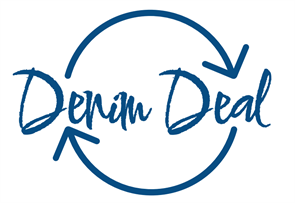Green Deal Circular Denim
Denim Deal
On October 29, 2020, 28 parties signed the Dutch Green Deal on Circular Denim (‘Denim Deal’). Signatories in the value chain, from producers, brands, retailers to collectors, recyclers and public authorities, have jointly developed an approach to take major steps towards using recycled textile in all denim garments marketed in the Netherlands. The signatories of the Denim Deal aim to close the denim loop by promoting the use of high-grade post-consumer recycled cotton fibres (‘PCR-cotton’) in new jeans and other denim garments. Since the start in October 2020 the number of signatories has grown significantly up to 53. The current Denim Deal runs for 3 years: from 2020 until the end of 2023.
Denim Deal goals
In the Denim Deal it has been agreed that brands such as, MUD Jeans, Garcia, PVH, 247 Jeans, and Kuyichi together make three million denim trousers (jeans) containing at least 20% recycled textiles. In addition, all parties have agreed that they will work together towards the standard of at least 5% recycled textile in all denim garments they put on the market as quickly as possible and will raise the bar in the future based on the learnings of the Denim Deal.
Former State Secretary Van Veldhoven, who signed the deal in 2020 on behalf of Dutch government: ‘The strength of this Denim Deal lies in the fact that all parties involved in the making and processing of a denim garment will participate, from production companies, brands and retailers, but also collectors, sorters, cutters and weavers. We are initiating a change in the entire chain. Once that step has been taken, scaling up will be easier afterwards. That will make this Denim Deal a blueprint for making garments made from other materials more sustainable’.
Look here for the official Denim Deal text
Look here for the English version of the Denim Deal text
Look here for the publication of the Denim Deal in the Government Gazette (Staatscourant) with the signatories until 1 July 2023.
Read the latest news about the Denim Deal.
Learn more about the Denim Deal
Are you interested in learning more about the Denim Deal? Have a look at the booklet Lessons of the Denim Deal 2020-2023 (pdf, 3.9 MB) or watch the after movie of the Denim Deal closure event. For an overview of the state of the art for using post-consumer recycled cotton in denim, have a look at this technical report (pdf, 3.6 MB).
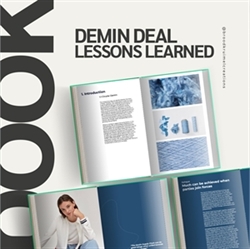
Denim Deal Coalition Partners
The Denim Deal will run for three years (October 2020 – December 2023) as an alliance of international frontrunners in the denim industry. Here, you can find the most recent overview of both public and private parties that have signed the Denim Deal (pdf, 404 kB).
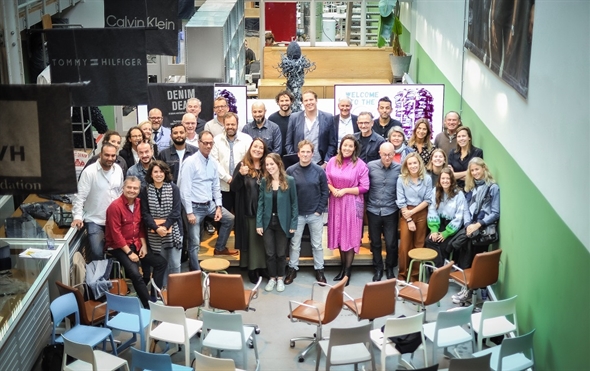
photo Rosa van Ederen
Monitoring
The signatories of the Denim monitor annually the activities they have undertaken, the results achieved, and their effect and challenges towards achieving the goals of the Denim Deal.
The monitoring system consists of both quantitative monitoring measured as progress towards the set ambitions, as well as qualitative monitoring in the form of questionnaires.
The first quantitative baseline report (pdf, 9.1 MB) 2020 shows the departure point for the Denim Deal. The monitor on 2021 (pdf, 2.9 MB) and the monitor on 2022 show the results in the first two years of the Denim Deal. Progress and results in 2023 will be reported in 2024.
Steering Committee
The steering committee’s primary task is to oversee general progress towards the objectives and agreements as stated in the Denim Deal, and to organise, facilitate and coordinate any necessary joint activities required to achieve these objectives and agreements. The steering committee consists of the following parties:
- Representative of Ministry of I&W Miriam van de Kamp
- Representative of local authorities Marten Boels (Metropolital Region of Amsterdam)
- Representative of the brands/retailers Nicolas Prophte (PVH)
- Representative of waste processing companies Jan Lamme (former CEO of Lamme Textiles and CEO Cibutex)
- Representative of the spinners/weavers Besim ÖZEK (Bossa)
- Representative of manufacturers Romain Narcy (Ereks Garment)
- Coordinator Roosmarie Ruigrok*
* The contribution of Amsterdam municipal authority to the role of the coordinator was supported untill June 2022 by the horizon2020 Reflow Project.
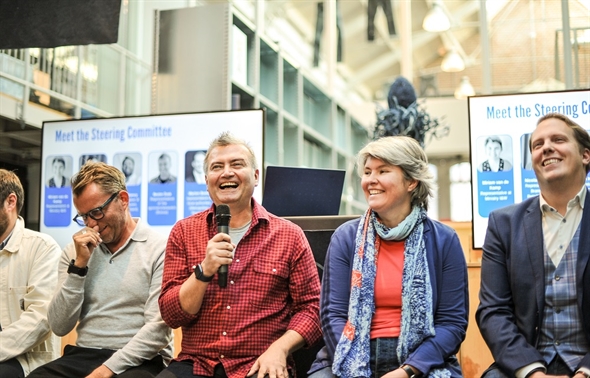
photo Rosa van Ederen
Working Groups
Participants of the Denim Deal are organized in working groups to collaborate on specific challenges within the textile industry. There are four working groups:
Transport
How to come to a better transport of goods from the Netherlands to other countries?
Parties experience problems with the shipment of non-wearable textiles to other countries. Parties within this working group will work together in order to come up with solutions for the shipment.
Update December 2022:
It is important to develop a sustainable strategy under what requirements non-wearable discarded garments (textile waste) can be exported to production countries where these can be recycled in fibres that can be used in spinning, weaving, and manufacturing of clothing and other textile products. The requirements should guarantee an environmentally responsible (better) treatment, authorised economic operators and a smart and efficient administrative process, to prevent unnecessary hurdles in the export of these secondary materials to the production companies which need those materials to become fully circular.
The plan (coordinated by the international department of the Dutch Ministry of Environment (IenW) is to involve the following stakeholders from Türkiye and the Netherlands:
- policy departments of the Ministries for the Environment,
- their Environmental Inspectorates, and
- the Customs offices.
Together they can investigate how the two countries could set up a system that would meet all the requirements, as stated above.
Quality
How to come to 3 million jeans with 20% PCR with the quality requirements of the brands?
At present, the use of recycled materials is often accompanied with price increases. The Denim Deal should develop new business models so that the deployment of PCR cotton in denim will become common use.
Update December 2022:
Many innovations are being developed and shared through denim and jeans fairs like Kingpins. For example, many brands are working with mechanical recycling combined with chemical recycling to achieve higher quality and percentage PCR without compromising the quality standards of the particular brand. The aim to use 20% in jeans and minimal 5% in other denim garments are easily reached at the moment. When only using mechanical recycling, the 20% PCR is currently the norm.
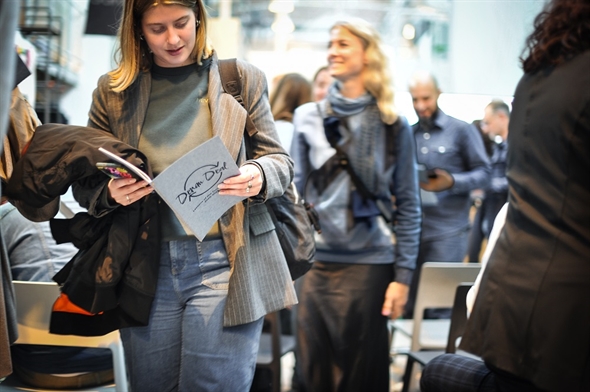
photo Rosa van Ederen
Transparency
What is the best way to be transparent about your activities to come to a circular business without green washing?
Transparency is important in order to show consumers that PCR cotton is actually incorporated into the Denim. This working group focuses on the question which communication tools can be used to inform consumers about the PCR cotton content of the clothing. There are several instruments already available on the market. Which instruments best suit the needs of the stakeholders involved in the Denim Deal?
Update July 2023:
With guidance from Retail partners, we looked at community-driven transparency for the partners within the denim deal. It became clear that the chain partners often use their own tools for this purpose. Full transparency in the chain is currently only common practice at product level and at individual brands. The NEN organized in May 2023 a workshop to find consensus on which requirements a transparency tool should have.
Guidelines Development fibers
Lead by: Jan Lamme, Nicolas Prophte, Laura Vicaria
How to enable effective collection and recycling of discarded textiles in order to facilitate access to high quality fibers?
The aim is to build a set of guidelines to bring alignment and facilitate the movement of sorted garments and recycled textile waste. The development brings specialists with technical knowledge of Denim Deal stakeholders together. The focus on developing guidelines is from the perspective of spinners, recyclers and sorters.
Source: https://www.youtube.com/watch?v=fLO8m1c-OKo
Why a Denim Deal?
Impact of the clothing industry
The clothing industry is responsible for around 4% of the global greenhouse gas emissions (source: Milieu-Centraal). Besides greenhouse gas emissions, the production process of textiles has a negative environmental footprint when it comes to the chemicals, (during the manufacturing process) and the use of land, water and pesticides (when growing natural fibers). When it comes to usage and consumption in the Netherlands, 57% of the textiles is disposed of in general waste and consequently incinerated after consumption (source: nulmeting beleid 2018). A Dutch consumer buys 50 pieces of clothing each year (source: Milieu-Centraal) while only 12% of the disposed textiles are recycled and 17% reused (source: nulmeting beleid 2018).
A next sustainable step for a cleaner textile industry
As these numbers show, there is a world to be gained in the textile industry when it comes to sustainable use of raw materials and increasing circularity throughout the industry. Therefore, the former State Secretary Van Veldhoven (circular economy and environment) has, together with 30 parties from the denim industry, taken a next sustainable step for a cleaner textile industry. The Denim Deal includes concrete agreements for more reuse of old denim garments. Van Veldhoven: 'I think we should work towards a cleaner textile industry for a healthy future and our climate. When we change our demand here, it will have an effect on how sustainably companies in Turkey and China, for example, produce, and will make us, as the Netherlands, no small player. What is so special about this Denim Deal is that, for the first time worldwide, all parties involved in the (denim) textile cycle - from brand, to collector and weavers - are taking up the challenge for a cleaner wardrobe together'.
A Circular Economy in 2050
In the Netherlands we are working towards a circular economy in which (textile) waste will no longer exist. If we re-use all our 'waste' in new products, it will save CO2 and prevent environmental pollution. The Dutch government has a Circular Textiles Policy Programme 2020-2025 with targets for the recycling of post-consumer textile waste and on the use of recycled content in new textile products in 2025 and 2030. The Denim Deal is part of this programme.
In addition to denim, the Dutch Government is working with the entire textile chain to implement extensive producer responsibility (EPR) for textiles, which means that the producer is responsible for the collection, reuse, recycling and waste treatment of textile products. With the Denim Deal and EPR, it should become easy for consumers to hand in worn-out jeans and jumpers and for producers to reuse or recycle them. Only in this way can we together ensure less discarded material, more re-use and less waste.
